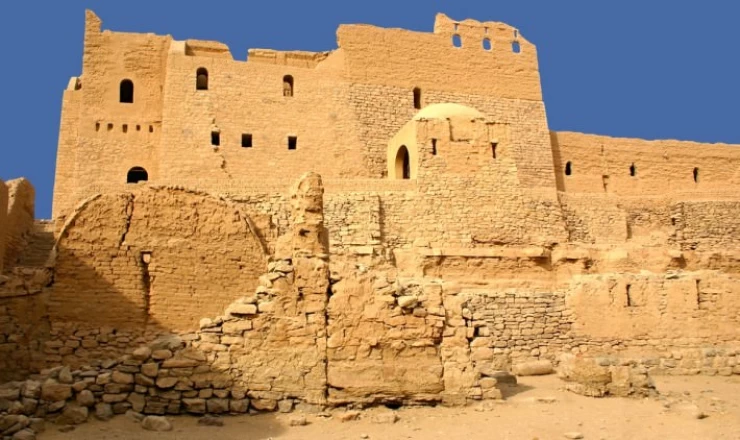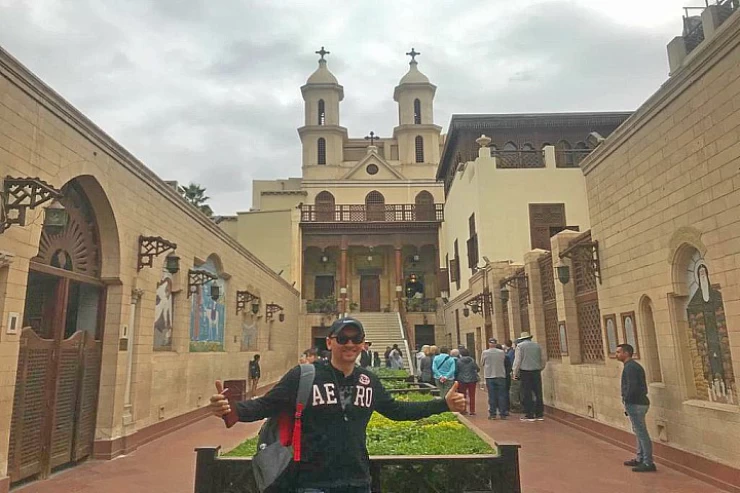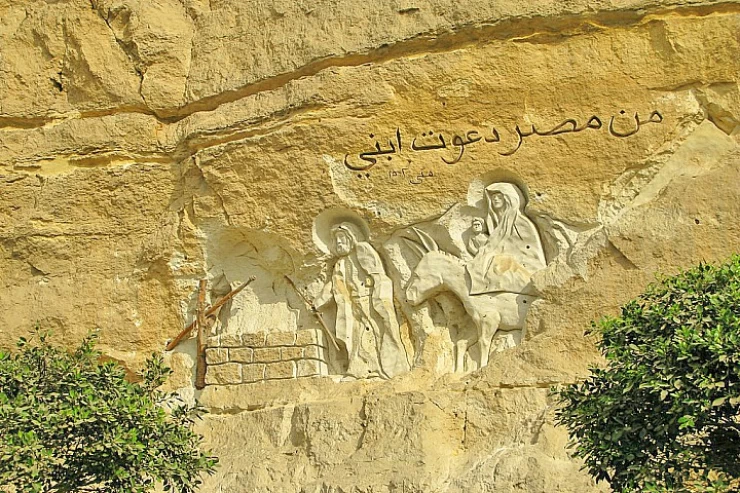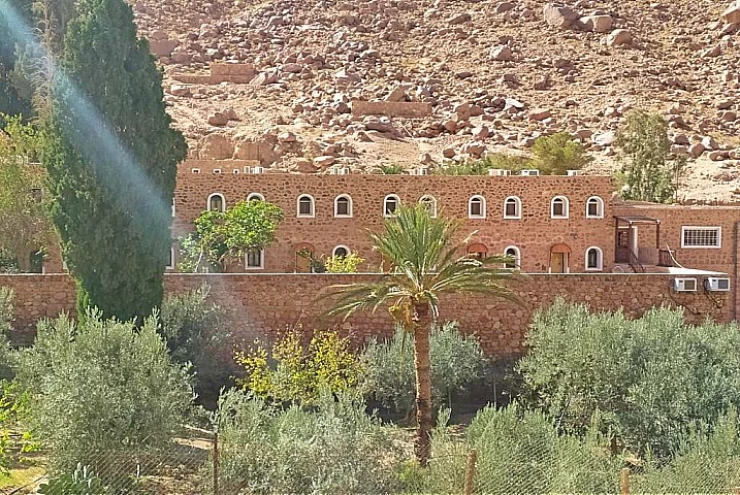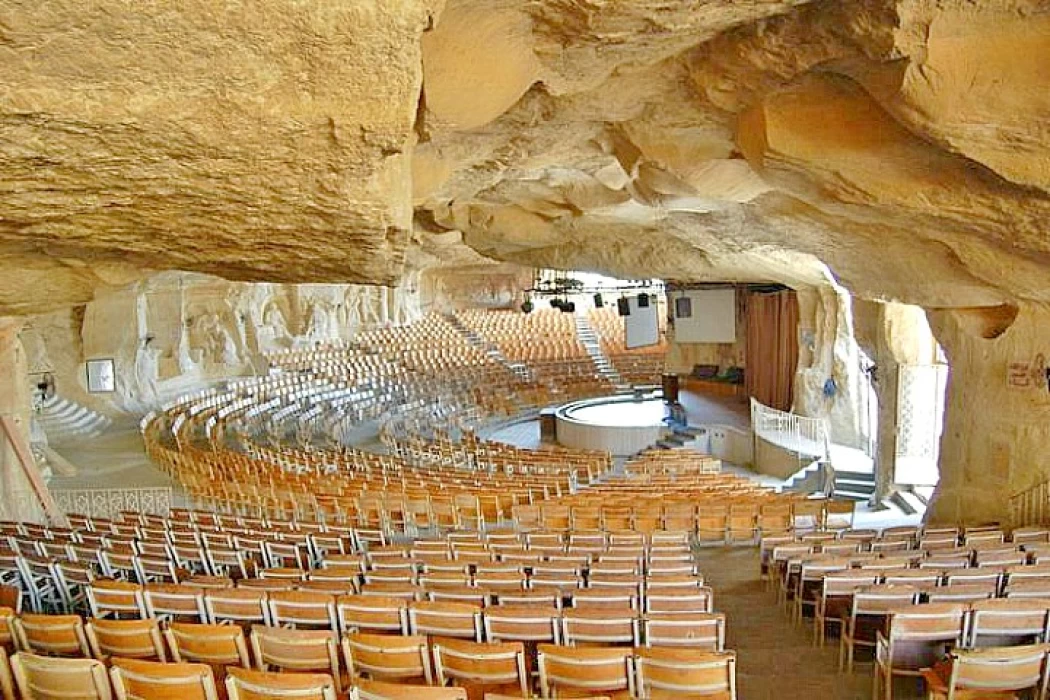
Monastero di San Simone il Conciatore
Il monastero di San Simone il conciatore
Una volta entrati nella zona del monte Mokattam e avvicinati all'area di Abagya, i tuoi occhi ti condurranno a uno dei manufatti architettonici più rari scolpiti nel cuore del monte Mokattam e uno dei segni creativi della montagna. L'alta montagna si fonde con l'architettura distintiva in cui è stato costruito il monastero, ed è diventata un sito visitato da un gran numero di turisti in tutto il mondo.
San Simone il conciatore era un artigiano che visse durante il X secolo e il suo monastero è considerato una delle cose da fare al Cairo, ma di solito non è visitato durante gli itinerari di breve durata e il Tour di un giorno al Cairo e la chiesa rupestre dedicato a lui potrebbe non durare per altri 10. Utilizzando una grotta preesistente e il pendio che portava al monastero può ospitare 20.000 persone su un pulpito centrale. Diverse grotte sono state anche formate in spazi separati della chiesa, e tutte sono state collegate per creare un enorme complesso cristiano nel cuore della città dei rifiuti. Centinaia di migliaia di persone fanno il pellegrinaggio ogni anno al monastero. Centinaia di migliaia di persone fanno il pellegrinaggio ogni anno al monastero.

La chiesa principale lì prende il nome dalla Vergine Maria e da San Simone in commemorazione della storia dell'apertura del monte Mokattam nel novembre del 979, quando Simone il conciatore è stato scelto per completare questo miracolo. La montagna di Mokattam si trova di fronte alla cittadella di Saladino ,che è totalmente fantastica.
Secondo gli storici, Ya'qub ibn Kulas, di origine ebraica, il ministro del califfo al-Mu'izz Ledin Ellah, era ferocemente anticristiano, e il califfo era un uomo di conoscenza e di letteratura. Quest'ultimo ha invitato il patriarca dei copti a discutere gli ebrei in materia di religione in sua presenza, e il patriarca ha risposto all'invito, accompagnato dal vescovo Sawyros Ibn Al-Maqfa. Durante la discussione, Sawyerus ha accusato gli ebrei di ignoranza, citando un versetto dal Libro di Isaia che dice: "Il toro conosce il suo bastone e l'asino è il proprietario del suo proprietario. Israele non lo sa! Il mio popolo non capisce! " (Isaia 1: 3). Ciò ha scatenato l'ira di Ibn Kallas, che ha deciso con uno dei suoi compagni di rispondere ai cristiani dando la caccia a un buco nei loro libri, e la sua ricerca ha concluso un versetto nel Nuovo Testamento in cui Cristo si rivolge ai suoi discepoli: "Se tu avessi fede come un granello di senape, diresti a questa montagna di andare di qui a là Così si muove, e niente ti è impossibile. "(Matt 20:17).
Il ministro presentò quel versetto al califfo e gli chiese di costringere i cristiani a provare l'affermazione del loro libro. Questo fece appello al califfo, che voleva sbarazzarsi della montagna a est del Cairo. D'altra parte, se i cristiani eludessero l'adempimento del versetto evangelico, sarebbe una prova dell'invalidità della loro religione e credenza. Al-Moez ha inviato il patriarca per informarlo della sua richiesta, minacciandolo se avesse fallito con gravi conseguenze e dandogli tre giorni per attuare questo. L'intera chiesa del paese durante quel periodo digiunava e pregava.
Il racconto religioso completa il racconto, parlando dell'apparizione della Vergine Maria al patriarca la terza mattina. Gli ho detto di andare a vedere un uomo che portava una brocca d'acqua, che sarebbe stato il prescelto per completare il miracolo sulle sue mani. Dopo aver eseguito il comandamento della Vergine, Simone trovò il Kharaz e gli raccontò quello che era successo. Quanto a quest'ultimo, ha chiesto al patriarca di rimanere tra la gente nel giorno previsto per spostare la montagna e da lì avrebbe eseguito la preghiera mentre il patriarca avrebbe tracciato il segno della croce. Ciò fu fatto, disse, quando si verificò un grande terremoto e la montagna si spostò finché il sole non ansimò sotto di essa. Dopo di che, Al-Kharaz è scappato in modo che nessuno potesse essere lodato.
Su 2 fasi furono costruite la Vergine Maria e la Cattedrale di San Simone. in primo luogo, era solo un'enorme grotta di calcare nella montagna. La seconda tappa è stata nel novembre 1994, in occasione della festa di San Simone. Intorno all'altare furono costruiti dei sedili fissi a forma di auditorium a quarto di cerchio per ospitare fino a cinquemila persone ed è per questo che divenne la chiesa più grande del Monastero.
Un'altra chiesa sorprendente nel monastero è la chiesa di San Bola, che prende il nome da San Bola il primo pellegrino per le virtù che possedeva. Ha vissuto in grotte e solitudine per 70 anni durante i quali non ha mai visto un volto umano.
La grotta della Cappella è stata scoperta nel 1986 durante i lavori di costruzione quando un'enorme roccia è caduta mostrando un'apertura nel soffitto della grotta. Una storia interessante su questa chiesa è avvenuta nel gennaio 1992 quando è stata messa in pericolo da un incendio causato da una scintilla elettrica. L'immagine di Gesù Cristo che si estende nella chiesa e l'altare non sono state danneggiate da nessuna parte mediana, anche se l'intero interno della grotta è stato danneggiato.

Poi abbiamo la chiesa di San Marco (che prende il nome da San Marco, il primo predicatore e considerata la prima chiesa in Africa ed Egitto) e San Simone il conciatore.
Il nostro team vi aiuterà a viaggiare in Egitto e sperimentare il tempo soleggiato del nostro bel paese durante la Pasqua, grazie alla loro vasta conoscenza del turismo egiziano. Puoi personalizzare il tuo pacchetto selezionando uno dei nostri pacchetti di viaggio in Egitto o sfruttare al massimo il tuo tempo in una breve visita, imparando di più sulla storia egiziana e le sue affascinanti storie e vivendola attraverso tour privati al Cairo. Partecipa a uno dei nostri tour economici in Egitto attraverso il deserto del Sahara, come i tour di Siwa dal Cairo, per esempio, o preferibilmente i tour nel Deserto Bianco d'Egitto. Scoprite i nostri tour di un giorno ad Assuan, fate una gita di un giorno da Assuan ad Abu Simbel, o viaggiate via terra e godetevi i nostri tour di un giorno a Luxor per vedere gli incredibili templi di Karnak, il Tempio di Luxor, il Tempio di Hatshepsut, e vedete le meravigliose tombe splendidamente dipinte nella Valle dei Re, questo è il luogo dove i re e i governanti del nuovo regno riposano in pace e imparate i loro riti di mummificazione e sepoltura.
È possibile scoprire molte cose interessanti su un edificio speciale chiamato Palazzo Barone Empain. Si trova in una grande città chiamata Il Cairo, in un paese chiamato Egitto.
A Hidden Gem in Cairo's Mokattam Hills .One of the most remarkable and beautiful historical places of worship is the Monastery of Saint Simon the Tanner, also known as the Cave Church, situated in the hilly, rocky Mokattam Hills of Cairo. Unlike the busy and crowded capital city of Egypt, this beautiful monastery does not only serve as a tranquil sacred space open to those who come in to seek the presence of God but rather possesses an exceptional view of walls sculpted into rocks forming the structure of the church. The very history of the place is almost more than ancient Coptic Christianity and the miraculous. For this reason, no matter how much in a hurry one is, a visit to this place is worth it for every religious lover wanting to explore Egypt’s religious mosaic.
The monastery is named after Saint Simon the Tanner, a Coptic saint from the 10th century who is most celebrated for a miracle during the rule of the Fatimid Caliph Al-Muizz. As per the Coptic tradition, it is said that during one of the reigns of the Copts, Al Muiz introduced a challenge to Pope Abram, the most senior leader of the Coptic Orthodoxy, to shift the Mokkatam mountain to illustrate that Christianity is true. After three days spent in prayers and fasting, Pope Abram had a vision of the virgin Mary, who asked him to look for Simon the Tanner. Simon, a simple leather craftsman who was very well connected with God, when the church gathered to pray, the mountain in question was raised, thus demonstrating the Christian religion to Al Muiz.
As a remembrance of this miracle, many centuries later, the large monastery compound in Mokattam was built in recognition of Saint Simon and the important event. At present, the monastery is also a monument to the Christian history of Egypt and the Christian context of the country.
The Monastery of Saint Simon the Tanner, which is located in the city of Cairo, is paradoxically quite remote. This monastery is located within Mokattam’s garbage city, wherein the Zabbaleen, are informal garbage cleaners of the city. The monastery, however, remains an island of peace amidst the turmoil. While the path to the monastery weaves through several narrow, twisting cores and squat buildings teeming with the city’s recycling activity, the view of the Cave Church’s gigantic rock-hewn altar is simply astounding.
The Monastery of Saint Simon the Tanner encloses an ensemble of several churches, each of exceptional interest: The most well-known and the one that leaves the greatest impression is The Cave Church, or, as it is more often referred to, The Church of Saint Simon the Tanner. This colossal area is hewn from the mountainside, making it the biggest church in the entire Middle East that can hold about 20,000 people. The inside of the cave is filled with religious images, paintings, and sculptures from the Holy Bible and the life of Saint Simon, which is all aglow with bright light coming from the rock ceilings. Above the cave, there are numerous cracks through which come rays of sunlight.
Within the compound, there are other notable churches such as:
The Church of Saint Mark: A compact but equally attractive church boasting soft stone carvings and quiet, contemplative areas for prayer and meditation.
The Church of Saint Bola: This church is also hewn from the rock and is cherished by tourists for its calm and peaceful interiors.
The Church of the Virgin Mary and St. Simon the Tanner: A congregation of faithful at a smaller church, where the churchgoers convene for daily masses and spiritual services.
Every church embodies a different spirit and embraces the beauty of nature along with the depth of spiritual culture.
The architecture of the Monastery of Saint Simon the Tanner is one of its most breathtaking features. The churches and spaces are not built conventionally but are hewed out of the rock of the Mokattam Hills. The use of natural, unprocessed limestone as the wall surfaces creates a rugged environment for the interior, allowing the guests to truly appreciate the ancient history of this place. This style of building also plays a part in enhancing the quality acoustic properties of the monastery, enabling the beautiful resonation of the Coptic liturgical hymns and chants all around the huge cave.
The outside view of the church complex is also exceptional. The corrugated grounds at the periphery of the monastery are embellished with high-relief sculptures and carvings that illustrate Biblical and Coptic cultural incidents. These high-stand carvings were done by a Polish sculptor, invariably hierarchy, thereby elevating the station of the site.
The Zabbaleen Connection
Over the last century, the Zabbaleen, a well-organized group of waste collectors or garbage collectors inhabiting the Mokattam region of Cairo, have had a very positive interaction with the Monastery of Saint Simon the Tanner. Most of the Zabbaleen are Copts, and like most communities in Egypt, they have suffered from troubles both social and economic. Nevertheless, a considerable part of this population has thrived in Garbage City through better integration of waste management and environmental services.
Though the purpose of the monastery transcends the physical boundary of the monastery, containing the Zabbaleen as it is, the monastery also offers hope and faith to these people. Some of the Zabbaleen assist in maintaining the monastery, and the place is important in their routine activity as a prayer and a meeting place. In addition to the monastery of Saint Simon the Tanner, a visit to the Zabbaleen's settlement reveals the extent to which their relentless work in recycling waste in Cairo went.
Religious significance and pilgrimage
The Monastery of Saint Simon the Tanner is a well-known place of pilgrimage for Coptic Christians not only in Egypt but also throughout the world. Many pilgrims primarily come to pray and meditate on the life and miracles of St. Simon. They seek inner healing and divine connection. The church also conducts regular services such as mass and other religious activities besides of the memorial services for Saint Simon, who is remembered annually on the 26th day of November.







